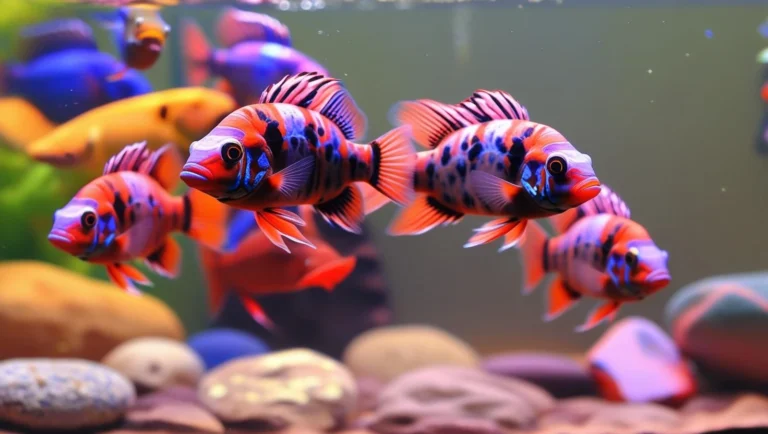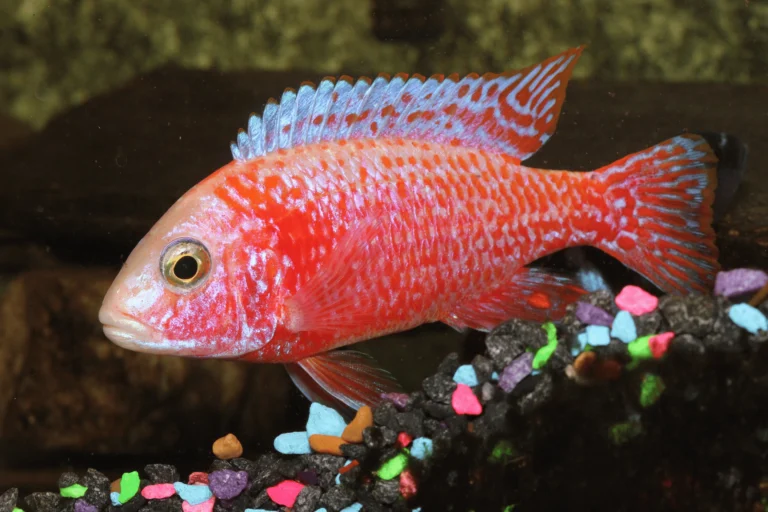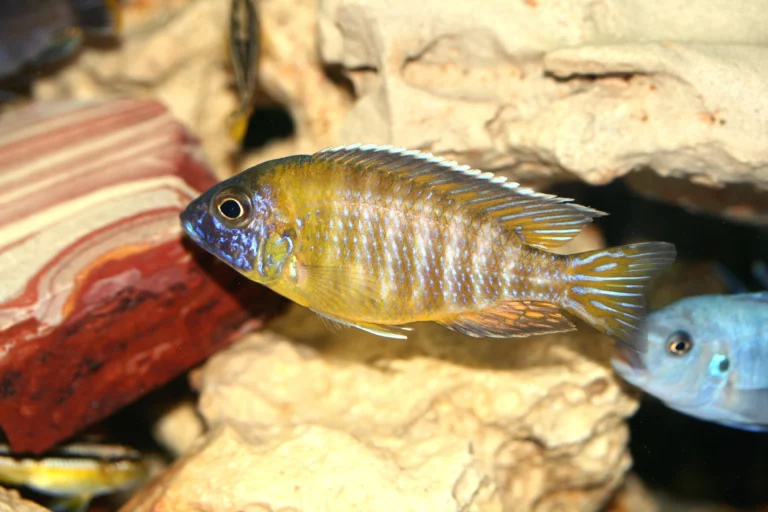Your trusted guide to cichlid care, tank setups, and quality products.

5 Essential Peacock Cichlid Growth Stages You Must Know
Witness the incredible transformation of peacock cichlids. Our comprehensive guide takes you on a journey from tiny fry to majestic adults, revealing the fascinating stages of their growth.
Image credits Canva
Peacock cichlids are among the most vibrant and colorful fish species you can add to your freshwater aquarium. Native to Lake Malawi in Africa, these stunning fish are prized by aquarists for their rich hues, ranging from deep blues to fiery reds. Understanding Peacock Cichlid Growth Stages is essential for successfully raising these fish, as each stage presents unique challenges and care requirements.
In this guide, Peacock Cichlid Growth Stages: From Fry to Adult, we will explore the stages of their development, discuss their dietary needs, and highlight behavioral changes. Whether you’re a beginner or an experienced aquarist, knowing how to care for your peacock cichlids at each stage is crucial to fostering a thriving, healthy tank.
At PeacockCichlid.com, we believe in transparency and honesty with our readers. Some of the links in this article are affiliate links, which means we may earn a small commission if you make a purchase through them—at no additional cost to you. These commissions help support our site, allowing us to continue providing expert advice, in-depth guides, and valuable content for Peacock Cichlid enthusiasts like you.
We only recommend products that we trust and believe will be beneficial for your aquarium. Thank you for your support!
1. Fry Stage (0-1 Month): The Beginning of Peacock Cichlid Growth Stages
The first stage in a peacock cichlid’s life is as a fry. Fry are tiny, newly hatched fish that measure less than 1 cm in length. They are mouthbrooded by the female, meaning the mother keeps the fry in her mouth for protection for the first few weeks after they hatch. This early stage is critical in the overall Peacock Cichlid Growth Stages.
Dietary Needs for Fry During the Early Peacock Cichlid Growth Stages
During the fry stage, peacock cichlids require specialized feeding. Their tiny mouths make it difficult to consume large food particles, so you must provide them with finely crushed food. Some excellent options include:
- Crushed flake food
- Baby brine shrimp
- Commercial fry food designed for cichlids
Frequent feedings, about 3-4 times a day, are essential to keep up with their rapid growth. Proper nutrition is critical for ensuring healthy fry development during these early Peacock Cichlid Growth Stages.
Behavioral Traits of Fry in the Initial Peacock Cichlid Growth Stages
Fry are highly dependent on a stable environment. Since they are small and fragile, keeping the water parameters steady is crucial. Fry are not aggressive and spend most of their time hiding and exploring. Provide plenty of plants and decorations to offer hiding places.
2. Juvenile Stage (1-6 Months): Key Peacock Cichlid Growth Stages
As peacock cichlids grow into juveniles, they become more robust and start displaying distinct features. Typically, they are around 1-2 inches long by this stage, though males and females are still difficult to distinguish. This phase of the Peacock Cichlid Growth Stages is marked by increasing independence.
Dietary Needs for Juveniles in the Peacock Cichlid Growth Stages
Juvenile peacock cichlids require a high-quality, protein-rich diet to fuel their growth. Suitable foods include:
- Small pellets designed for cichlids
- Bloodworms (live or frozen)
- Brine shrimp
Feed them 2-3 times daily to support their rapid growth. A varied diet is vital to ensure their continued development through these Peacock Cichlid Growth Stages.
Behavioral Changes in Juveniles
Juveniles become more active and social, marking a significant shift in the Peacock Cichlid Growth Stages. Social hierarchies may start forming, with dominant juveniles asserting control. While males may show faint aggression, it is less pronounced compared to adults.
3. Sub-Adult Stage (6-12 Months): Maturing in Peacock Cichlid Growth Stages
The sub-adult stage is a time of significant growth spurts and developing physical traits. Males start exhibiting brighter colors and elongated fins. This stage of the Peacock Cichlid Growth Stages typically sees fish reach 3-4 inches in size.
Dietary Needs for Sub-Adults in the Peacock Cichlid Growth Stages
Sub-adult peacock cichlids benefit from a diet that supports growth and color enhancement. Consider feeding them:
- Cichlid-specific pellets
- Spinach or other greens
- Frozen or live brine shrimp and bloodworms
- Occasional vegetable matter (such as zucchini)
Twice-daily feedings suffice at this stage. A balanced diet ensures that males develop vibrant colors, a hallmark of mature peacock cichlids.
Behavioral Changes in Sub-Adults
Sub-adults show clear signs of sexual dimorphism, with males becoming territorial. Behavioral changes are a hallmark of this phase in the Peacock Cichlid Growth Stages. Males start claiming territories and may court females, though breeding is more common in adulthood.
4. Adult Stage (1 Year and Beyond): The Final Phase of Peacock Cichlid Growth Stages
By the time peacock cichlids reach adulthood, they have fully developed their characteristic colors and behaviors. Males grow to 4-6 inches and display striking colors and larger fins, while females remain smaller and less colorful. This stage represents the culmination of the Peacock Cichlid Growth Stages.
Dietary Needs for Adult Peacock Cichlids
Feeding adults is straightforward but still important for maintaining health and vibrancy. Their diet should include:
- Premium cichlid pellets
- Spirulina-based foods
- Live or frozen daphnia and bloodworms
Feeding once or twice daily is sufficient for adult fish. Maintaining a balanced diet supports their health and longevity during the final Peacock Cichlid Growth Stages.
Behavioral Changes in Adults
Adult males are extremely territorial and will aggressively defend their chosen areas. If multiple males are in the same tank, you may witness behaviors like fin flaring and chasing. Providing a large tank with plenty of hiding places can help reduce conflict during these mature Peacock Cichlid Growth Stages.
5. Breeding Behavior: A Key Aspect of Peacock Cichlid Growth Stages
Breeding is an exciting part of the Peacock Cichlid Growth Stages. Males display bright colors to attract females and create territories for breeding. After fertilization, females mouthbrood the eggs until they hatch. Fry emerge ready to begin their own Peacock Cichlid Growth Stages.
Dietary Considerations for Breeding
A protein-rich diet supports breeding fish. Ensure females have access to food post-mouthbrooding, as they may not eat during the process.
Key Challenges and Tips Across Peacock Cichlid Growth Stages
- Fry Care: Set up a nursery tank to protect fry from predation and provide a controlled environment.
- Juvenile and Sub-Adult Aggression: Provide plenty of space and tank structures to reduce territorial disputes.
- Adult Breeding: Balance the male-to-female ratio (1 male to 3-4 females) to minimize stress and aggression.
Conclusion
Understanding Peacock Cichlid Growth Stages from fry to adulthood is essential for their care and long-term health. Each stage presents unique challenges and rewards. By paying attention to their diet, behavior, and environment, you can help your peacock cichlids thrive, displaying stunning colors and fascinating behaviors.
If you found this guide helpful, share it with fellow aquarists and let’s continue fostering healthy environments for these magnificent fish. For more information on peacock cichlids, visit www.peacockcichlid.com, your go-to resource for expert advice and tips.
If you enjoyed learning about the essential growth stages of your Peacock Cichlids, be sure to explore our other expert articles to further enhance your aquarium experience. For instance, discover invaluable tips in Breeding Peacock Cichlids: 5 Proven Tips for Massive Success and 10 Proven Tips to Master Peacock Cichlid Diet and Breeding to optimize your fish’s health and breeding potential. If you’re looking to refine your aquarium environment, don’t miss Peacock Cichlid Tank: 10 Expert Tips for a Stunning Setup and Peacock Cichlid pH Stability: 10 Powerful Steps for Success for practical advice on maintaining a vibrant, balanced tank.
At peacochcichlid.com, we’re dedicated to providing you with comprehensive care and maintenance insights, so be sure to visit us again soon and follow our social media channels for more tips, updates, and aquarium inspiration!
FAQ’s
What are the main Peacock Cichlid Growth Stages?
The primary stages are Fry (0-1 month), Juvenile (1-6 months), Sub-Adult (6-12 months), and Adult (1 year and beyond). Each stage has unique dietary and behavioral characteristics.
How can I ensure healthy growth during Peacock Cichlid Growth Stages?
Provide a balanced diet tailored to each stage, maintain stable water parameters, and offer a well-structured tank with ample hiding places.
When do Peacock Cichlids start showing their vibrant colors?
Males typically begin developing bright colors during the Sub-Adult stage (6-12 months) and fully display them by adulthood.
How do I reduce aggression in adult Peacock Cichlids?
To minimize aggression, ensure your tank is large enough and includes plenty of hiding spaces. Maintaining a proper male-to-female ratio also helps reduce stress.
Can I breed Peacock Cichlids during the early stages?
Breeding usually begins around 6-12 months but is most successful after they reach full adulthood. Ensure the tank environment is suitable for breeding and provide proper nutrition.



